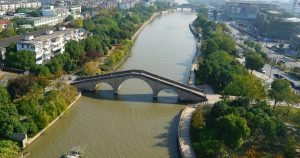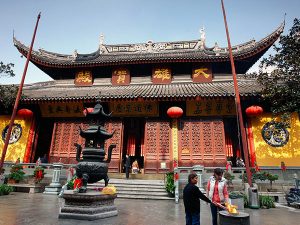Malcolm gave us an interesting presentation capturing the highlights of his travels in China. It took the form of an hour-long digital audio/visual film with excellent photography and commentary. To sum up – China is on the move and is now a modern technological and industrial powerhouse. China is thought to be the oldest continuous model of civilisation. The rest caught up and China became isolated and secretive. Times have changed, with many believing the turning point was around the time of the Beijing Olympics in 2008 when China welcomed athletes and visitors from all over the world. China is now more open, allowing its subjects to travel and students to study abroad. Tourists and businessmen are now encouraged.

Malcolm was particularly taken with Chinese classical gardens with its topiary, bonsai creations. The stonework is white with no shape repeated, all to complement the greenery. No flowers are present to distract the flow. Water features and areas of tranquillity were common and viewed through tantalisers to give focus and frame the magnificent views. China’s Grand Canal was another feature on the tour, being the longest (1,100 miles) as well as the oldest canal or artificial river in the world. The canal links north and south China, running from Beijing to Hangzhow and linking five rivers including the Yangtze and Yellow. The Grand Canal shows in abundance the old and the new, with cement and brickworks lining the banks to supply the ever expanding and needy construction and housebuilding industries. Locals go about their business as they have for centuries, fishing, boat building and moving goods in their flat bottom boats. Today, tugs tow as many as 20 barges along the canal to make life easier and more profitable. The silting of the canal is a common problem and dredgers are in constant use to keep the channels open.
A highlight of the visit was the city of Shanghai, a global financial hub of 24 million people (2018), being the biggest and richest city in China. The city rivals New York and Paris in terms of modernity and is a major tourist destination with its many landmarks. The streets and markets are teeming with people, both locals and visitors. Shanghai retains its past with many Buddha temples including the Jade Buddha Temple.

Religion was not banned by the communists but not encouraged. Today Buddhism is gaining popularity and the temples are again busy as centres of the community and worship. Shanghai has the largest suspension bridge in the world and, to demonstrate that the city is ever expanding, land which was marshland 10 years ago is now wall to wall buildings. All this comes at a price – pollution!
As a complete contrast to frenetic Shanghai, the last lap of the tour was to the Chinese Southern Region with its mountains and lush steep-sided valleys, and, by comparison, sparsely populated. Simply, it is a ‘must’ for tourists who wish to see China at its most beautiful and contrasting.
